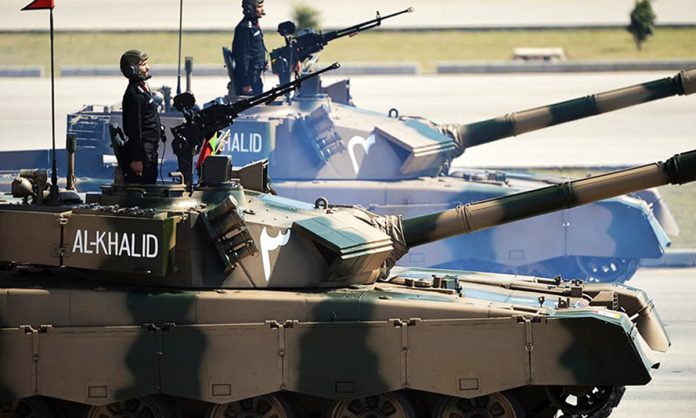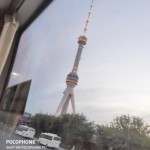Mirza Kashif Baig
Introduction
Pakistan’s armored forces play a crucial role in its defense strategy, particularly given its geopolitical position and security challenges. The Pakistan Army’s tank fleet, featuring the Al-Khalid, Al-Zarar, and Haider, is the backbone of its armored capabilities. These tanks represent a blend of indigenous development and foreign technology, tailored to meet the region’s unique needs.
This article aims to provide an analytical comparison of these tanks against some of the world’s leading main battle tanks (MBTs), assessing their strengths and areas for improvement. Additionally, it will explore the strategic steps Pakistan could consider to enhance its armored capabilities in the future.
Al-Khalid Tank
The Al-Khalid, developed through a collaborative effort between Pakistan and China, is a third-generation main battle tank. It entered service in the early 2000s and has since been a cornerstone of Pakistan’s armored forces. The tank is named after the famous Muslim general Khalid ibn al-Walid, symbolizing strength and resilience.
Specifications and capabilities:
- Armament: The Al-Khalid is equipped with a 125mm smoothbore gun capable of firing a range of ammunition, including armor-piercing, high-explosive, and anti-tank guided missiles (ATGMs). It also features a 12.7mm coaxial machine gun and a 7.62mm machine gun for anti-infantry roles.
- Armor and Protection: The tank utilizes composite armor, with additional explosive reactive armor (ERA) for enhanced protection against shaped charges and kinetic penetrators. This makes it relatively well-protected in conventional battlefield scenarios.
- Mobility: Powered by a 1,200 horsepower diesel engine, the Al-Khalid boasts a top speed of around 72 km/h and a range of approximately 500 km. Its advanced suspension system allows for good off-road mobility.
Comparative Analysis: When compared to global contemporaries like the American M1 Abrams, the German Leopard 2, and the Russian T-90, the Al-Khalid is positioned as a capable but somewhat underpowered tank. The M1 Abrams, for instance, benefits from advanced composite armor and a more powerful 1,500 horsepower engine, offering superior protection and mobility. The Leopard 2, renowned for its accuracy and fire control systems, outperforms the Al-Khalid in targeting and engagement range. Meanwhile, the T-90, a more direct competitor, offers similar firepower but with better armor protection due to advanced ERA systems.
Despite these challenges, the Al-Khalid’s cost-effectiveness, ease of maintenance, and adaptability to the harsh terrains of South Asia make it a valuable asset for the Pakistan Army. However, to keep pace with evolving threats and technological advancements, there is a need for continuous upgrades in areas such as armor protection, fire control systems, and engine power.
Al-Zarar Tank
The Al-Zarar is an upgraded version of the older Type 59 tanks, originally of Chinese origin, which have been in service with the Pakistan Army for several decades. The Al-Zarar program was initiated to extend the operational life of these tanks and enhance their capabilities to match modern battlefield requirements.
Development and Upgrades: The Al-Zarar project involved a comprehensive upgrade package, including improvements to firepower, protection, mobility, and electronics. The tank’s main gun was upgraded to a 125mm smoothbore cannon, replacing the older 100mm rifled gun, allowing it to fire a variety of modern ammunition types, including high-penetration rounds.
Key features and improvements:
- Armament: The upgraded 125mm gun is capable of firing armor-piercing fin-stabilized discarding sabot (APFSDS) rounds, high-explosive anti-tank (HEAT) rounds, and ATGMs, providing versatile engagement options. The tank is also equipped with a coaxial 7.62mm machine gun and a roof-mounted 12.7mm anti-aircraft machine gun.
- Protection: The Al-Zarar features improved composite armor and ERA panels, significantly enhancing its survivability against modern threats. It also includes an automatic fire suppression system and NBC (nuclear, biological, chemical) protection.
- Mobility: The tank’s engine has been upgraded to a 730 horsepower diesel engine, providing a maximum speed of 65 km/h and an operational range of 450 km. The suspension and track systems have also been improved for better off-road performance.
Comparative Analysis: Compared to modern MBTs, the Al-Zarar stands out for its cost-effectiveness and the practical use of available technology to enhance older platforms. However, it faces limitations in terms of overall armor protection, firepower, and advanced electronic systems when compared to newer tanks like the M1A2 Abrams or the Leopard 2A7, which feature superior armor composites and advanced targeting systems.
The Al-Zarar, while a significant improvement over its predecessors, still lags in areas like advanced night vision, laser rangefinding, and data-linking capabilities, which are standard in more recent MBTs. Despite these drawbacks, the Al-Zarar remains a viable option for the Pakistan Army, offering a substantial upgrade at a fraction of the cost of acquiring new tanks.
Haider Tank
The Haider tank represents the latest addition to Pakistan’s armored fleet, focusing on integrating modern technology to address the limitations observed in earlier models. This tank aims to bridge the gap between Pakistan’s indigenous capabilities and the latest advancements in armored warfare technology.
Introduction and Capabilities: The Haider tank program is part of Pakistan’s ongoing efforts to modernize its armored corps. It incorporates a range of advanced features, including improved armor, enhanced firepower, and state-of-the-art electronics.
Technological innovations:
- Armament: The Haider is equipped with a 125mm smoothbore gun, capable of firing the latest ATGMs and advanced kinetic energy projectiles. The tank also features a remotely operated weapon station (ROWS) with a 12.7mm machine gun, enhancing its capabilities against infantry and low-flying aircraft.
- Protection: The Haider uses advanced composite and reactive armor, similar to those used in modern Western tanks. Haider’s base protection consists of welded steel and composite armor, and a laser warning system is mounted on the turret roof to alert the crew if targeted by laser rangefinders or laser designators.
- Electronics and Battlefield Awareness: The Haider is equipped with advanced optics, night vision, and thermal imaging systems, allowing for superior target acquisition and engagement in all weather conditions. Its fire control system is also linked to a battlefield management system, providing real-time data and communication capabilities.
Positioning Against Global Competitors: The Haider aims to compete with the latest generation of MBTs, such as Russia’s T-14 Armata and South Korea’s K2 Black Panther. While the exact specifications and capabilities of the Haider are closely guarded, it is expected to include many of the features found in these leading tanks, including advanced active protection systems, superior mobility, and robust firepower.
Comparative analysis
Overall, Pakistan’s tank fleet, while capable, faces challenges when compared to the world’s top MBTs. The Al-Khalid, Al-Zarar, and Haider each offer unique strengths but also have limitations, particularly in areas like advanced armor protection, electronic warfare capabilities, and active protection systems. Modern tanks like the M1 Abrams, Leopard 2, and T-14 Armata have set high standards in these areas, often incorporating the latest technology to enhance survivability and lethality.
Strengths and weaknesses:
- Strengths: Cost-effective production and maintenance, suitable for regional operational environments, and continuous upgrade potential.
- Weaknesses: Generally inferior in terms of advanced armor and electronic systems, less powerful engines, and lower integration of cutting-edge technology like APS and advanced fire control systems.
Recommendations for Pakistan’s future steps
To maintain and enhance its armored capabilities, Pakistan could consider the following steps:
- Technological Upgrades: Invest in modernizing existing tanks with advanced armor systems, electronic warfare capabilities, and active protection systems.
- Strategic Partnerships: Seek collaborations with technologically advanced nations to acquire cutting-edge technologies and integrate them into indigenous designs.
- Manufacturing and Training: Enhance domestic manufacturing capabilities and provide advanced training for tank crews to effectively utilize new technologies.
Conclusion
Pakistan’s tank fleet, with the Al-Khalid, Al-Zarar, and Haider, forms a critical component of its defense strategy. While these tanks offer a robust platform for regional defense, continuous modernization, and technological upgrades are essential to keep pace with global advancements in armored warfare. By focusing on key areas for improvement and leveraging strategic partnerships, Pakistan can ensure its armored forces remain competitive and capable of addressing future challenges from its eastern border.
The author is the Editor of Monthly Interaction.







